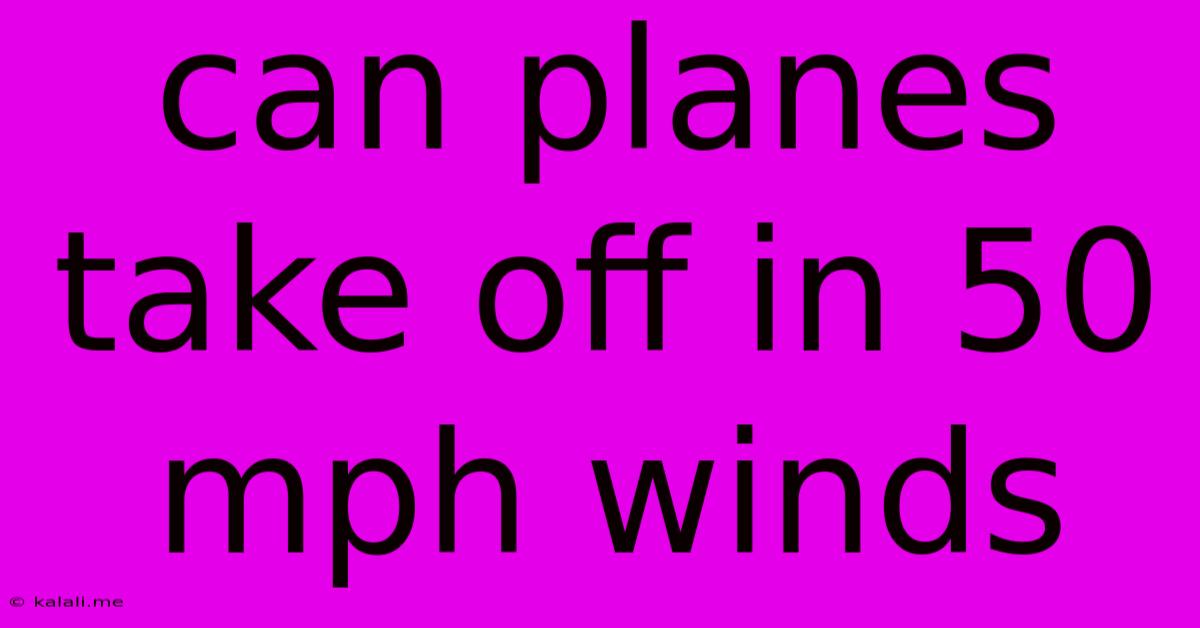Can Planes Take Off In 50 Mph Winds
Kalali
May 21, 2025 · 3 min read

Table of Contents
Can Planes Take Off in 50 mph Winds? A Comprehensive Look at Wind and Aircraft Operations
Meta Description: Discover the truth about aircraft takeoff in high winds. We explore the impact of 50 mph winds on aircraft performance, safety regulations, and the factors that determine whether a flight can proceed.
High winds present a significant challenge to aircraft operations. A seemingly simple question – can planes take off in 50 mph winds? – requires a nuanced answer. While 50 mph winds aren't automatically a flight-stopper, the feasibility depends on several crucial factors. This article delves into the complexities of wind and aircraft takeoff, explaining the limitations and safety procedures involved.
Understanding Wind's Impact on Takeoff
Wind speed isn't the sole determinant. Wind direction plays a critical role. Headwinds, blowing directly against the aircraft's direction of travel, actually assist takeoff. They increase the aircraft's ground speed, allowing it to reach its required lift-off speed more quickly and over a shorter distance. Conversely, tailwinds, blowing in the same direction as the aircraft, reduce the ground speed, requiring a longer runway and potentially higher speeds to become airborne. Crosswinds, blowing from the side, are the most challenging, creating lateral forces that can destabilize the aircraft during takeoff and landing.
50 mph Headwinds vs. Tailwinds vs. Crosswinds
-
50 mph Headwind: While seemingly extreme, a strong headwind can sometimes be beneficial. Modern aircraft are designed with considerable safety margins, and pilots are trained to handle various wind conditions. The reduced ground roll can be advantageous, particularly on shorter runways.
-
50 mph Tailwind: This presents a much greater risk. The reduced ground speed necessitates a longer runway to reach the necessary lift-off speed. If the runway is too short, takeoff may be impossible. Furthermore, the increased airspeed at lift-off can create challenges in maintaining control, increasing the risk of exceeding safe operating limits.
-
50 mph Crosswind: This is generally the most problematic scenario. Strong crosswinds can cause the aircraft to veer off course during takeoff and landing. Pilots use various techniques, including differential braking and rudder control, to compensate, but there are limits to their ability to counteract extreme crosswinds. Beyond a certain threshold, dependent on the aircraft type and runway conditions, takeoff will be aborted for safety reasons.
Aircraft Type and Design
The aircraft's design significantly influences its ability to handle strong winds. Larger aircraft, with their greater weight and wingspan, typically have better wind tolerance than smaller ones. Furthermore, advanced flight control systems on modern jets help mitigate the effects of wind shear and gusts, enhancing safety margins in challenging conditions. However, even the most sophisticated aircraft have operational limits.
Runway Length and Condition
The length and condition of the runway are paramount. A longer runway provides more distance to accelerate and reach the required takeoff speed, especially in the presence of tailwinds or crosswinds. Runway surface conditions, such as wet or icy surfaces, can further reduce traction and impact the aircraft's ability to accelerate safely.
Pilot Expertise and Decision-Making
Ultimately, the decision to take off in high winds rests with the pilot. Their experience, judgment, and assessment of all relevant factors – wind speed and direction, runway conditions, aircraft capabilities, and weather forecasts – are crucial. If the pilot deems the conditions unsafe, the flight will be delayed or canceled. Safety always comes first.
Conclusion
In conclusion, a blanket "yes" or "no" answer to whether planes can take off in 50 mph winds is insufficient. The impact of wind on takeoff is multifaceted and depends on several interconnected factors. While headwinds might be manageable, tailwinds and especially crosswinds pose significant challenges. The pilot's assessment of the specific situation, combined with the aircraft's capabilities and runway conditions, determines whether a flight can safely proceed. Safety protocols and stringent regulations ensure that only flights deemed safe are allowed to operate.
Latest Posts
Latest Posts
-
How To Stop Paint From Flaking
May 21, 2025
-
Is A Middle Name A Forename
May 21, 2025
-
Thank You For Your To This Matter
May 21, 2025
-
One Tick On Whatsapp But Not Blocked
May 21, 2025
-
Can I Bring Toothpaste On My Carry On
May 21, 2025
Related Post
Thank you for visiting our website which covers about Can Planes Take Off In 50 Mph Winds . We hope the information provided has been useful to you. Feel free to contact us if you have any questions or need further assistance. See you next time and don't miss to bookmark.